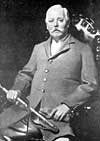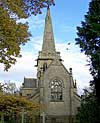For this church:    |
|
 R M Knowles R M Knowles |
The new church was built by Robert Millington Knowles in memory of his wife and of his son John Knowles, who was drowned having taken up the offer of a day’s fishing aged 21.
The Church was built to a grand scale in white using the early perpendicular style but was not thought to be ostentatious for the time it was built in and has subsequently been described by Pevsner as one of the most beautiful village churches in England.
The building work was carried out by Messrs Bell and Sons, in a white stone to the designs of Arthur W Brewill of Nottingham who was strongly influenced by the Tractarian ideals of the time. It was consecrated on 2 August 1892 by the Bishop of Southwell.
In 1912 it was reported that there were 56 children in the village school, and 28 on the roll of the Sunday School. The vicar had conducted five baptisms over the previous twelve months.
In 1934 it was noted in the Southwell Diocesan Magazine that the spire of this church needed restoration work carried out after a lightening strike caused a survey to be carried out which revealed faulty construction methods. The work to correct these faults cost £300.
In addition to this the Rev Young noted that although erected as recently as 1892, by 1934 its condition was so dangerous that the west end of St John’s had to be shored up and considerable repair work carried out. The cost of the works was defrayed by the then Squire, Sir Edward Le Marchant and his wife, who was the daughter of the founder. The Bishop of Southwell reopened the repaired church on 12 August 1936.
The Bells have been rehung from St Mary’s Church thus providing continuity between the two buildings, with the exception of the tenor bell which was recast. In 1902 two new bells were presented by Mr R M Knowles, and Lady Margaret Knowles presented one bell, bringing the peal to a total of eight.






